How to refresh your company values: an employee-led approach

Do your values no longer reflect who you are or how you work? Have they become invisible? Here’s how we undertook an employee-led refresh of our company values: and the lessons we learned along the way.
Done right, core values are a powerful tool for organizations to differentiate themselves: the building blocks of your culture.
They can steer decision-making, attract (and retain) top talent, communicate who you are to customers. They are your identity, principles, your philosophy.
Companies with a high sense of purpose outperform those without purpose by as much as 400%.
But what if your values are no longer fit for purpose? How do you approach an overhaul, without ruffling feathers or ending up with another set of obsolete buzzwords?
Happiness: the key to business success
How do you know it’s time to refresh your company values?
Creating company values should be done for the long-term: they’re not something you can simply ‘jazz up’ at will or re-do each year. If you change them too frequently, they lose their meaning and (excuse the pun) value: they should be a consistent, foundational part of who you are as a business.
But.
Holding onto values that have stopped having any role or meaning in your organization is just as damaging as having no values at all. For us, there were a few red flags that suggested it was time to take another look.
- We had undergone a period of rapid growth and significant change as an organization: including a change in senior leadership, international expansion into the US, and taking on a number of new staff.
- Our values no longer reflected who we were or how we worked. We had grown, but our values hadn’t grown with us.
- Most staff couldn’t remember all of them; a couple were recited when asked, but rarely in full. They had largely become invisible.
- They were top-down values, defined by management with no input from staff and therefore, didn’t have staff buy-in or support.
- They were perceived as ‘gimmicky’ and just buzzwords, affiliated with our internal recognition program – where staff could #hashtag a value when nominating a peer – but not values we actually lived and breathed as a business.
- Several were what would be regarded as ‘expected behaviors’: for example, honesty, or being adaptable. These are of course honorable attributes, but arguably, expected of all individuals we interact or work with. They weren’t what defined or set us apart as an organization.
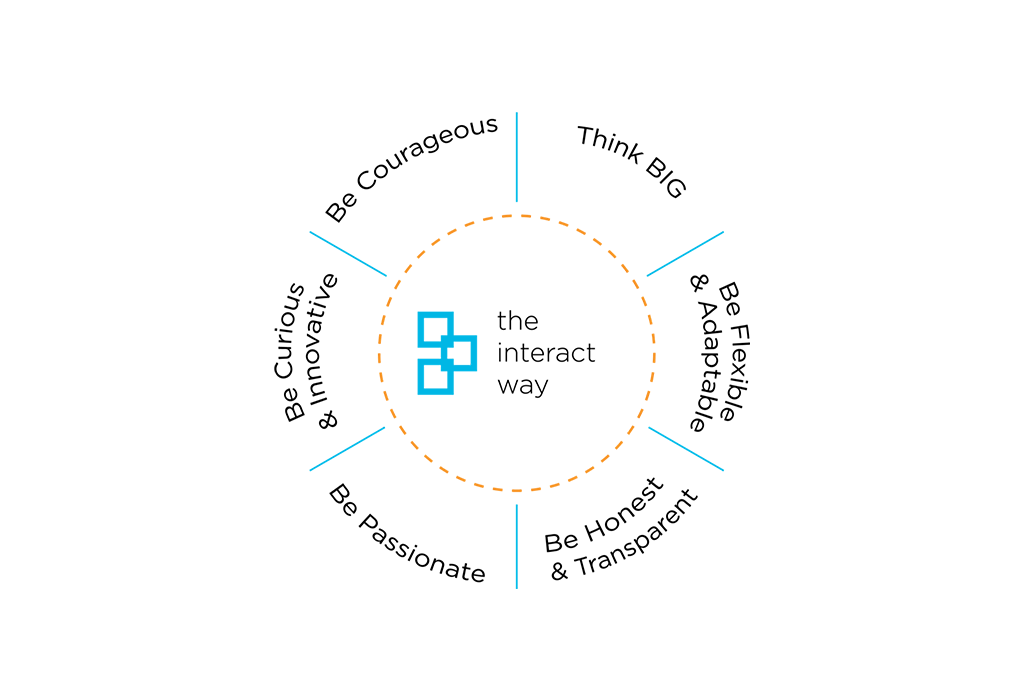
No organization is static, and as we grow, evolve, and change, it may become necessary for our values to change too.
Having recently undergone a significant external rebrand, our senior leadership team set the wheels in motion for the same internally: starting with a fresh look at the very principles of who we are and what we do.
The process: how we (re)created our values
If these values were going to be authentically us, we needed to keep a completely open mind.
– Tim Gough, Head of Professional Services
Although the challenge and task was set by senior management, that’s where their involvement ended. It was really important to our leadership team that this time, the values were bottom-up: coming from staff, and not the other way around.
The project was managed by Head of Professional Services, Tim.
“Before undertaking the project, I spent some time talking with SkyBet, a customer of ours who had recently undertaken a refresh of their own values,” explains Tim.
“Every company is different, but it helps to learn from those who have gone before you and get an idea of how to approach it. Perhaps one of the most important things I took away from those conversations was to come to sessions with no pre-conceptions of what a ‘good’ value is: if these were going to be authentically us, we needed to keep a completely open mind.”
Step 1: Workshops
To facilitate an employee-led approach, the first step was to undertake workshops. All employees were given the opportunity to contribute globally through 7 workshops across both the UK and US offices, and one-to-one sessions held with remote workers.
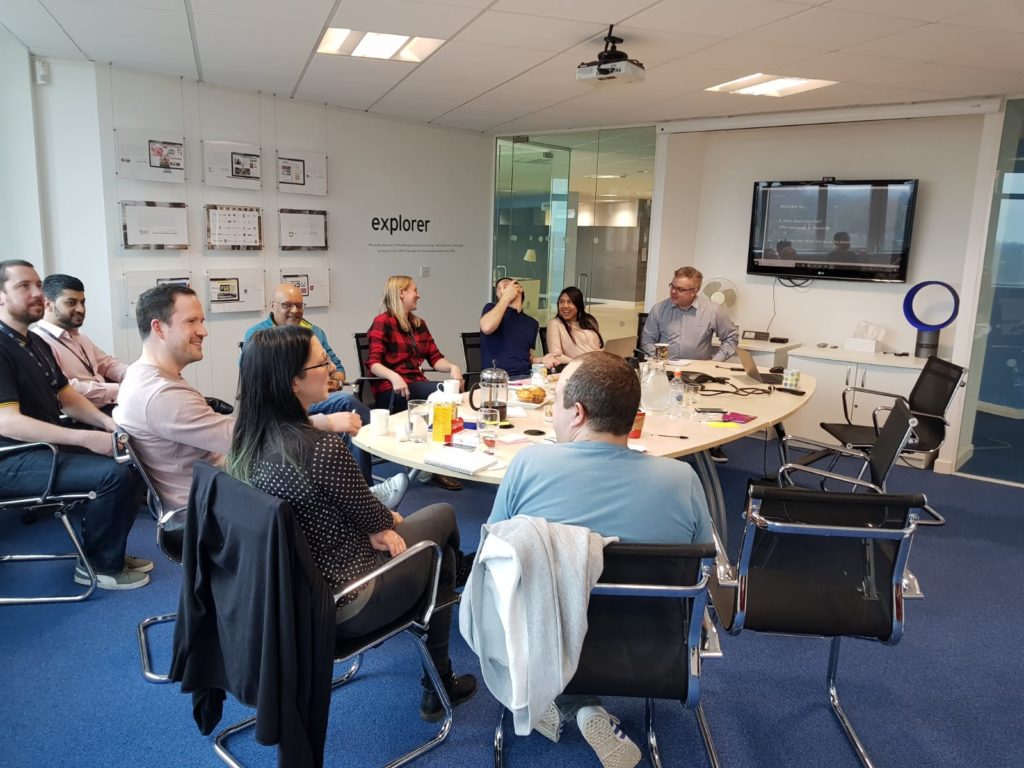
All workshops welcomed staff from across different departments to create a diverse group and encourage a variety of contributions.
The process was simple. Employees were asked two basic questions:
- What would you miss about working at Interact?
- What do you do every day that makes Interact what it is?
“The idea was to steer away from aspirational, ‘pie in the sky’ ideals of what we want to be: these questions were designed to focus employees on who we are now,” explains Tim.
“Our values are supposed to articulate who we are as an organization and what we stand for. By wording these questions in this way, we stopped people going after the generic buzzwords and phrases that too often end up stuck on office walls and forgotten about. The goal was to get a real understanding of how our employees see and value working here.”
Staff scribbled down their responses – as many as they could conjure – on post-its, which were then stuck up on the wall under the appropriate question heading.
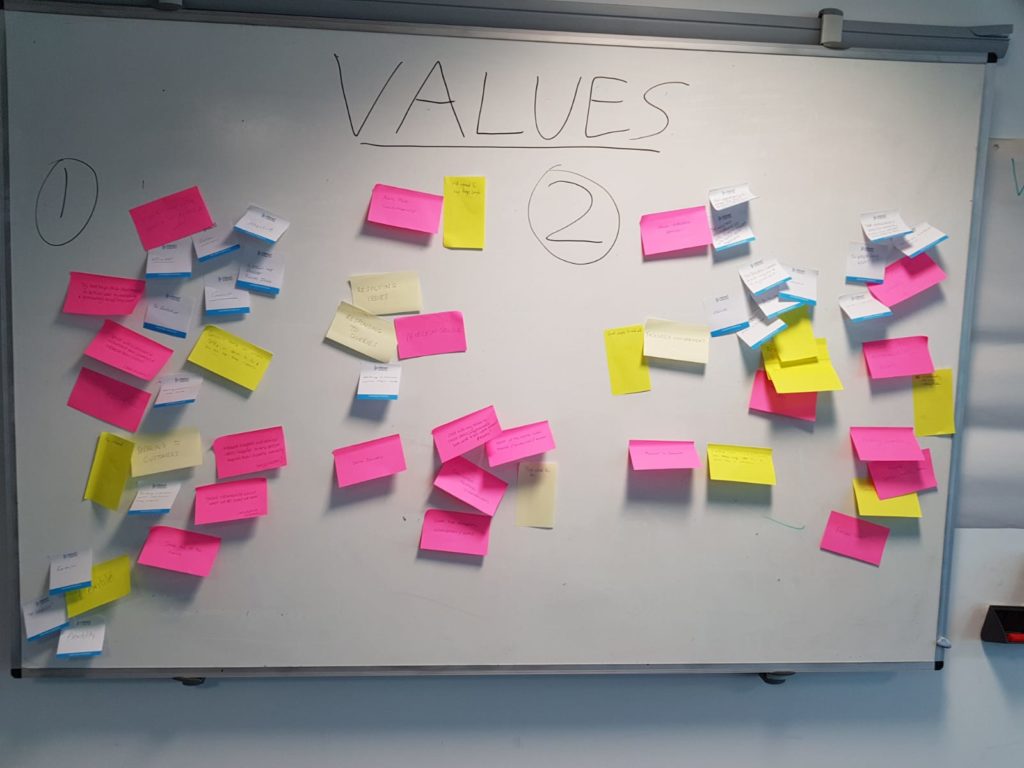
Similar posts or those saying the same were then grouped together, and responses shared among the group to generate some discussion and ideas.
“Every session brought up something new. However, from the get-go there were clear patterns and trends appearing. Almost everyone said they’d miss the people, for example; it was overwhelmingly the most common answer to the second question about what people would miss most.”
Answers ranged from the business-focused – such as, “establish relationships with customers”, or “fix bugs in the product”, through to the more informal and light-hearted – “I’d miss Martin / the pool table / Friday lunch / listening to Pete’s cat stories”, and more.
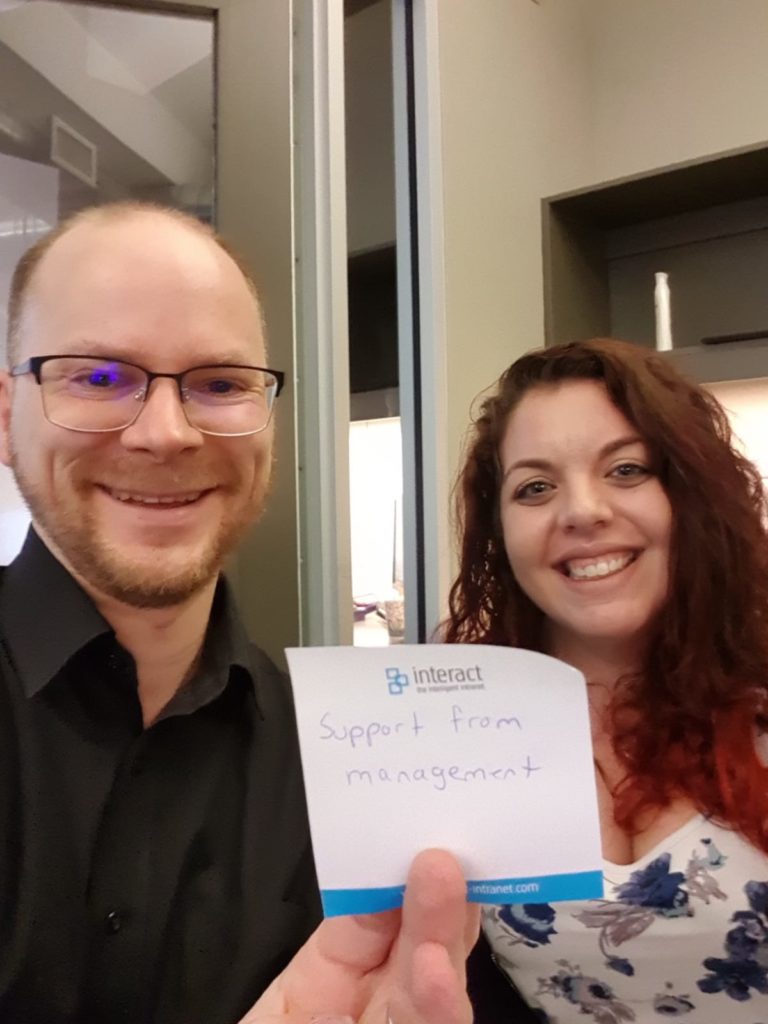
Step 2: Deciphering the data and fine-tuning
Every response generated across the different workshops was collated into a spreadsheet and then evaluated in depth by Tim.
If you ask the right questions, listen, and then have the data from that to back up your choices, you’re far more likely to be successful.
Tim Gough, Head of Professional Services, Interact
Similar ideas and responses were grouped, and themes picked out or repeated words/phrases highlighted. From these high-level themes, we needed to identify – and define – our values as a business.
“It’s important to spend time really reviewing responses and searching for those patterns: employees have given their time and input, and this recognizes the value of their contributions and lets them know we’ve really heard them,” explains Tim.
“That’s crucial for getting buy-in and support for the final values.”
With a handful of key themes and trending words or phrases, Tim then assembled a small sub-group to help evolve those into concrete values.
“You won’t please everyone. Trying to get a large group to agree on something of this magnitude is invariably going to present challenges. But if you ask the right questions, listen, and then have the data from that to back up your choices, you’re far more likely to be successful.”
The sub-group went back and forth over the course of a few weeks; assigning wording and then sitting with it, debating it, refining it. A number of variations and evolutions were proposed before everyone came to an agreement.
Happiness: the key to business success
Step 3: Defining the values

Given the scale of input from employees and the amount of discussion supporting the wording of the values, a few buzzwords or catchphrases weren’t going to cut it. It was important people were made aware of the path from their contributions, to the final result.
To help achieve this, the final version of the values included:
- The value: a single, short and recognizable phrase that could be recalled easily
- A summary sentence: giving a top-level overview of what the value covered
- A deeper explanatory paragraph: building on the summary to detail what it encompassed and picking out discussion points from both the workshops and the sub-group
- Examples from values sessions: the contributions from staff that related to that value
The effect was a funnel or triangle: with staff contributions at the base, and the value at the top.
This is our first value, in that format:
We put people first.
People are at the heart of who we are and what we do: our colleagues, our customers, our prospects.
Our purpose is to connect every organization’s greatest asset: it’s people. Putting people first is a principle we apply to everything we do, both internally and externally. Whether it’s putting the user first in the design of our software and the services we deliver or supporting our colleagues and peers as part of a connected team, we always put people first.
Examples from values sessions:
- Support my team/colleagues
- Give passion across to my customers
- Improve customer experience
- Build relationships
- Help my team
- Help others
- Teamwork
- Banter
- Have a laugh
- Listen to Pete’s cat stories
- Help customers
- Help customers achieve
- Think of the customer, always
- Make customers feel listened to
- Making technicalities customer friendly
- Delivering a product our customers enjoy using
- Customer’s view of the product and how we value them
- Provide customer knowledge
- Internal team working
- Trying to engage with people across different departments
- [would miss] my co-workers
- Social events
- Martin Malone / Trevor
- The people
- My team
- The people I work with
With the final values defined, they were then presented to senior management.
These new values capture the culture and ethos of Interact and most importantly, they have the complete buy-in from the employees who helped create them.
Simon Dance, CEO, Interact
“It was important to the whole senior leadership team from the outset that these values be employee-led, not defined by those at the top,” says Simon Dance, CEO.
“Tim and his team did an excellent job getting everyone engaged with the project and exploring what they truly value about being a part of Interact. When the final version came to us, we were confident these truly represent who we are and what we do.
“These new values capture the culture and ethos of Interact and most importantly, they have the complete buy-in from the employees who helped create them.”
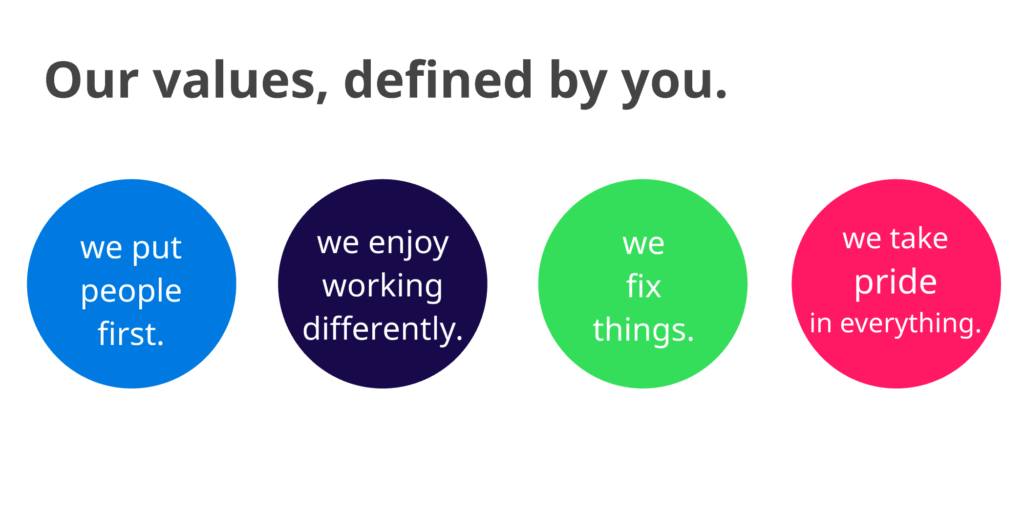
With no edits to the wording and just minor feedback on the ordering of the values, the new Interact values were finalized.
Step 4: Communicating the values

While the values were generated from a bottom-up perspective, communicating the final decision to employees needed backing from a senior level. This approach would show that management was on board, lend gravitas and authority to the final decision, and help embed the values into the culture of the organization.
Interact CEO, Simon presented the values within small group business update sessions. In this setting, employees were free and able to provide feedback or ask questions.
A presentation opened by reminding staff of the old values, explaining the need for change and giving an overview of the process undertaken.
Next, staff contributions began to appear before zooming in on the keywords featuring in each individual value. From this, the full value and definition would appear. The effect was for individuals to see their own contributions transforming into the final value.
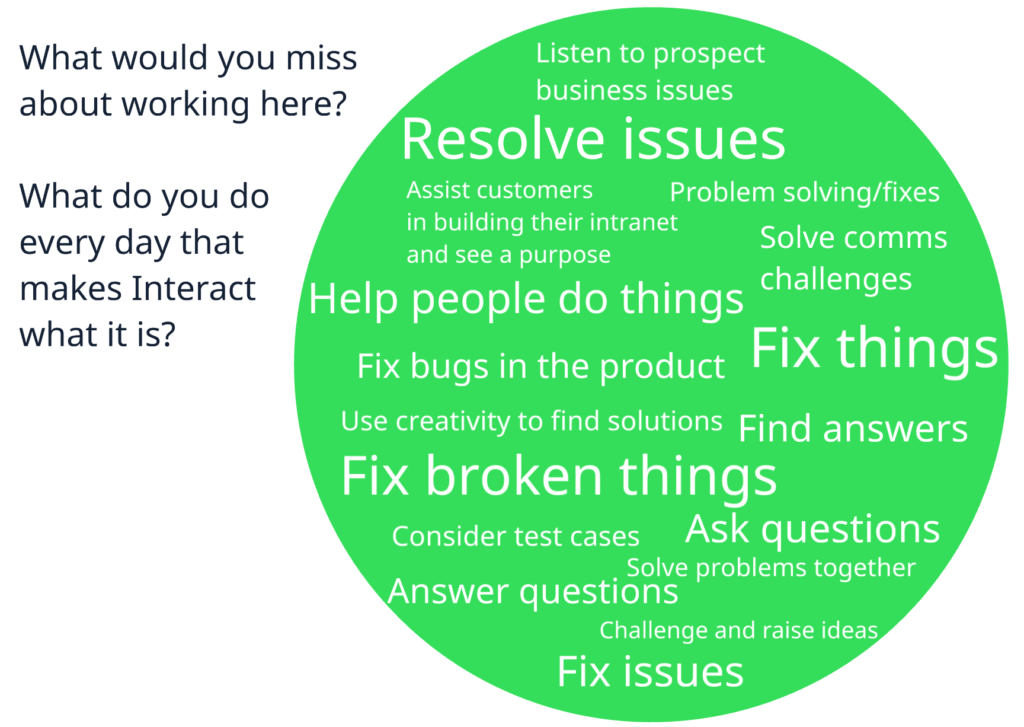
Finally, we demonstrated how these were already a part of who we are as a business: by looking through recent peer recognition comments from our intranet that matched each value.
The presentation delivered by Simon to all Interact employees:
Step 5: Embedding and branding the values
We didn’t want our values to become redundant or forgotten. Ensuring they remain front-of-mind and embedded into how we operate day-to-day is crucial to their longevity and success.
The first step to achieve this came in the form of identifying and approaching individual members of staff to become values ambassadors. This group would then assume responsibility for coming up with ideas for championing the values and installing them into everyday life at Interact.
“I stepped up to be a values ambassador because the process, for me, really demonstrated how important these are to the business and everyone in it,” says Emma, Marketing Manager and Values Ambassador.
“Participating in the project meant I really believed in these and what they stood for: I could see how they came about, what they meant to staff and how they related to who we are and what we do. I feel like that’s a message every member of staff at Interact needs to hear.”
We sought to get people from different areas of the business, looking for staff to represent different departments, levels of seniority, and length of tenure. We included both UK and US-based staff, along with a remote worker. Internal influencers who already demonstrated buy-in or contributed to internal conversations regularly were a natural choice.
Our internal designer then concepted up branding for the values by producing mood boards; feeding in our external brand colors and imagery, but injecting the words and some associated images for each value. These evolved to become our value icons:
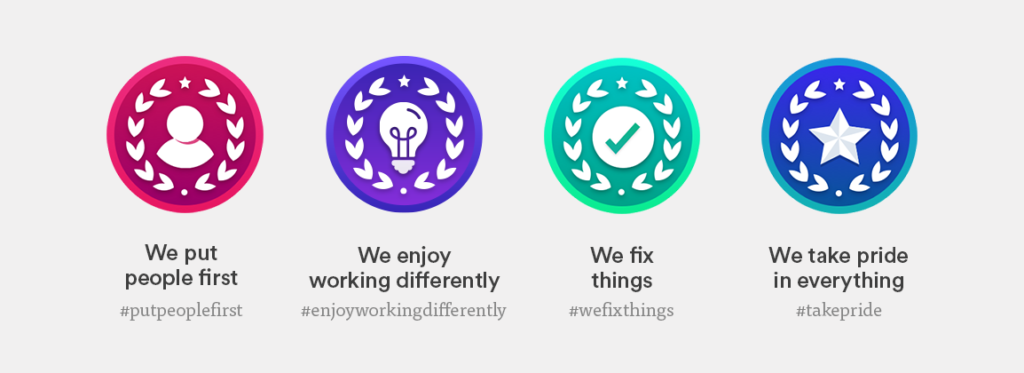
Each was assigned its own hashtag, designed for use in our peer recognition program. A new dedicated area of our intranet was created for showcasing the new values, including the presentation and a call for additional ambassadors.
Happiness: the key to business success
Step 6: Evolving our value-based peer recognition program

With the support of Interact Strategist Kelly Freeman, our HR and Talent Director Amy then initiated an overhaul of our quarterly values recognition program.
Overall, the new program has rewarded some really impactful and extremely customer-focused achievements that may have been missed in the days of the old award program.
– Amy Needham, HR and Talent Director
The existing process saw individuals with the most peer rewards with a value #hashtagged each quarter shortlisted, with the vote then going out to all employees to select the winner.
However, the process tended to see the same individuals appearing in the shortlist each quarter. Some members of staff, by the nature of their role, will have the opportunity to interact and engage with more departments or individuals; or will do more internally-based work, likely to receive both face time and recognition from their peers.
The result was more of a ‘popularity contest’ based on volume rather than quality of rewards. It failed to acknowledge the ‘unsung heroes’ who may operate more under the radar or in the background of the business, but were no less deserving of recognition for living and breathing our values as an organization.
“With the creation of our new values, which are considerably more aligned to our company culture, I felt it was also time to look at how we can reward displays of our values in everyday work,” says Amy.
“Our existing award program was starting to lose its appeal and wasn’t having the same positive impact that it did initially.”
Under the new process, employees continue to #hashtag values when awarding recognition to their peers, with an explanation of why they’re giving that person a shoutout. The full list of rewards given in that quarter is then submitted to all middle managers who review and select an individual each to be shortlisted, explaining why they believe that person has demonstrated or embodied the Interact values.

Even if that person has been nominated just once, they are still eligible to be considered: on the basis of why they were acknowledged, rather than the number of times. The shortlist is debated by senior management, who then select the winner for the quarterly values award.
“The new program focuses less on the number of Donuts awarded for displaying the values and more on the reason for the rewards. We also moved the final decision of the winner to involve the management and leadership teams (rather than being an employee vote),” explains Amy.
“Removing the employee vote was a big step that I felt could have had a negative response from employees, however, it received a really positive response. Overall, the new program has rewarded some really impactful and extremely customer-focused achievements that may have been missed in the days of the old award program.”
The future of the Interact values

Our commitment to bringing our values to the forefront of our business is continual and ongoing.
Among the ideas proposed by ambassadors for consideration going forward, we’ll be considering how to bring the values into our physical workspace, the use of staff video interviews to champion the values, and how to feed the values into our hiring and onboarding process.
Values champions are also looking to do a relaunch of the values, dedicating a week to each value with various activities, awareness content pieces and more to keep them front of mind.
Feedback overall has been extremely positive and buy-in to the new values from all staff is clear. With careful planning, a bottom-up approach and clear, evidence-based communication throughout the process, the team has mitigated many of the risks associated with organizational change. We now have values that truly represent who we are and what we do.

